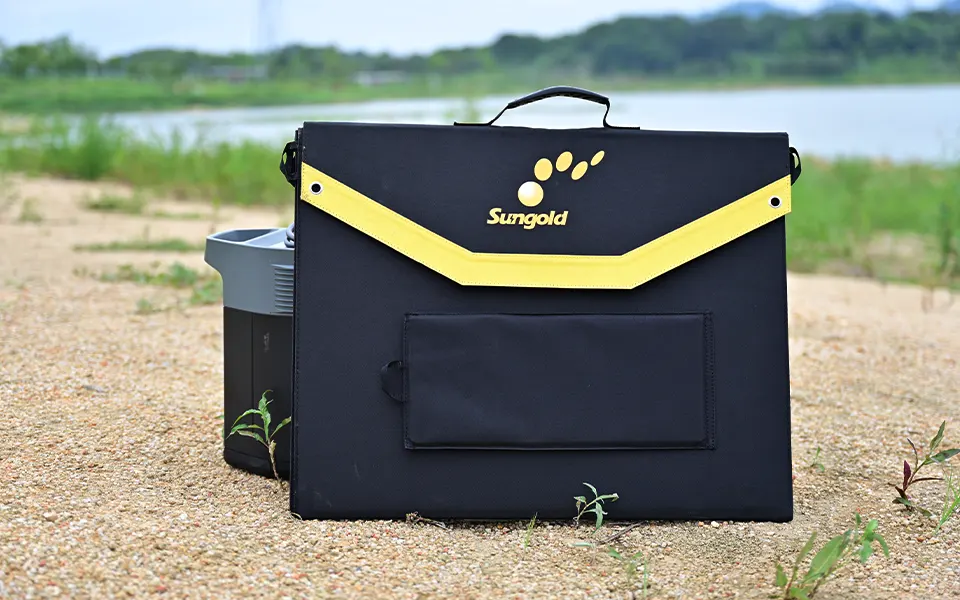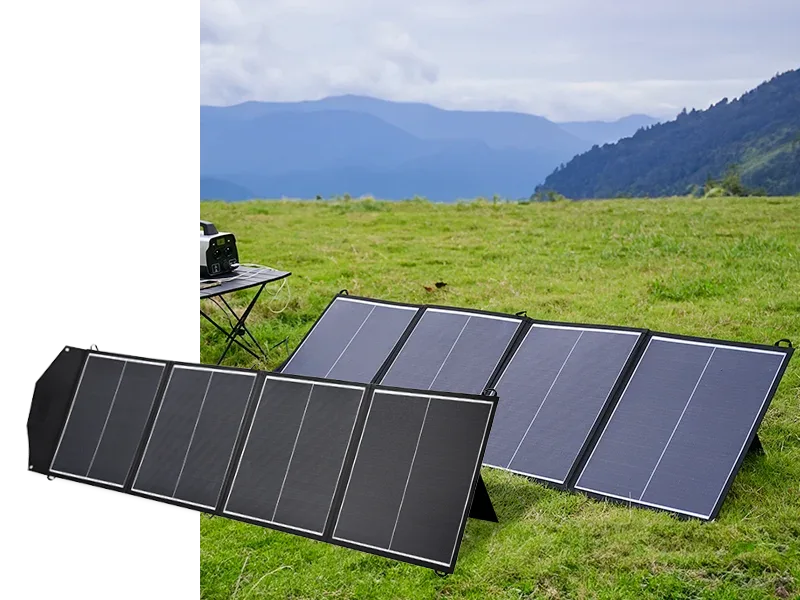Camping offers a unique opportunity to disconnect from your daily chores and immerse yourself in nature. However, staying comfortable and powered up has become an important part of this experience.
Portable solar panels have changed how campers live by providing them with a sustainable, reliable, and convenient energy source. Here are 9 reasons why you need portable solar panels for your off-grid camping setup:
The compact size makes them easy to carry
Portable solar panels are designed to be lightweight and compact. This means that you can easily carry them along with your other camping gear without adding too much weight or bulk. They are perfect for campers who like to travel light and need an energy source that doesn’t take up too much space.
Easy to use
Portable solar panels are very user-friendly. With a plug-and-play setup, you can have them up and running in no time, even if you don’t have technical expertise. Simply place them in a sunny spot, connect the device, and start generating power. This ease of use makes them ideal for campers of all experience levels.
Emergency backup power
When off-grid, it is vital to have a reliable backup power source. Portable solar panels can charge batteries and power vital equipment, ensuring you’re never left in the dark in an emergency. Whether it’s charging your mobile phone for help or powering a torch, solar panels give you peace of mind.

Camp in comfort and convenience
Your camping trip will be more comfortable and convenient with electricity. You can power small appliances such as lights, fans, and portable fridges. This means you can cook your meals, keep your food fresh, and create a cozy campsite environment to make your camping experience more enjoyable.
Create the Ultimate Off-Grid Setup
Portable solar panels enable you to create the ultimate off-grid camping setup. By harnessing the power of the sun, you can generate electricity anywhere, making it possible to camp in remote locations without sacrificing modern conveniences. This setup allows you to enjoy the beauty of nature while still having access to the necessary power.
Improve the cooking setup at your campsite
Portable solar panels can greatly improve your camping cooking setup. You can power portable cookers, electric grills, and other cooking appliances. This allows you to prepare meals more efficiently and enjoy a wider variety of foods while camping, thus enhancing your overall outdoor cooking experience.
Low Maintenance
One of the major advantages of portable solar panels is the low maintenance requirement. With few moving parts, they are durable and require minimal maintenance. This means you can spend more time enjoying your camping trips without having to worry about the maintenance of your power source.

Cost-effective power source
While the initial investment in portable solar panels may be high, the long-term savings are considerable. Once you have solar panels, the energy they produce is free. This eliminates the ongoing costs associated with fuel or disposable batteries, making it a cost-effective solution in the long run.
Outdoor charging capabilities
Portable solar panels are incredibly versatile. They can charge everything from smartphones and tablets to cameras and portable power stations. addition, they can power a wide range of camping equipment, ensuring you have all the essentials for a comfortable and enjoyable trip.
Avoid the hassle of having your mobile phone or laptop battery die miles away from an electrical outlet with portable solar power. Solar mobile power with embedded panels can also be used to charge devices directly using stored solar energy. Whether you want to listen to music for hours on end or have backup communication capabilities, portable solar panels can keep your must-have technology running. Off-grid charging can reduce problems if the power supply is interrupted.

Car and motorhome compatibility
Portable solar panels are designed to be compatible with cars, caravans, campers, and other vehicles. Their plug-and-play design includes cables and adapters that easily connect to your car or motorhome battery for charging while parked or driving. This gives you a reliable way to keep your battery from draining without having to leave the engine idling to recharge.
When stationary, the battery plates can be fixed to the roof or bonnet of your vehicle using magnetic panels, suction cups, or other mounting systems. For campervans or motorhomes, portable solar panel kits that come with the vehicle can be used to maintain electrical usage and power needs when off-grid. The portability of portable panels makes them the perfect addition to a vehicle’s solar energy needs.
Which type of solar panel is best for camping?
The solar panel technology you choose will depend on your needs for cost, efficiency, and ease of installation.
Camping solar panels made from Sunpower cells generate the most electricity. These solar panels are perfect for caravans if you need a lot of electricity to live comfortably, or if you want to charge your batteries faster. Regular monocrystalline solar panels can also produce a decent amount of electricity while saving you money. While this technology is less efficient, it is also less costly.
Portable solar panels are great for use on the ground while camping, or mounted on the roof of your RV using a mounting bracket. Semi-flexible solar panels, however, are suitable for the roof of an RV because of their lightweight and flexibility.

Other components of a portable solar panel system
A typical portable solar panel system for camping or overlanding consists of the following components:
Charge controller
A charge controller regulates the flow of electricity from the solar panel to the battery, preventing overcharging and optimizing the charging process. There are two types of charge controllers: PWM (pulse width modulation) and MPPT (maximum power point tracking). MPPT controllers are more efficient and recommended for larger solar systems or in situations with fluctuating light conditions.
Battery
The battery stores the electricity generated by the solar panel for later use. There are several types of batteries used in portable solar panel systems, including lead-acid, lithium-ion, and lithium-iron phosphate (LiFePO4). Each type has its advantages and disadvantages, such as capacity, weight, lifespan, and cost. When selecting a battery, consider factors such as power needs, budget, and the intended duration of your camping or overlanding trip.
Inverter
An inverter converts the DC (direct current) electricity stored in the battery into AC (alternating current) electricity, which is required for powering most household appliances and devices. Portable solar panel systems typically use either modified sine wave or pure sine wave inverters. Pure sine wave inverters provide cleaner and more stable power, making them preferable for sensitive electronic devices.
Wiring and connectors
Wiring and connectors are essential for connecting the various components of your portable solar panel system. Ensure that the wiring is of appropriate gauge and length for your specific setup and that the connectors are compatible with your chosen solar panels, charge controller, battery, and inverter.
5 steps to install a portable camping solar system
Installing a portable solar panel system for camping or off-roading requires the following steps:
- Step 1: Choose a suitable location
Choose a location that receives direct sunlight for most of the day and is free of obstacles such as trees or buildings. Depending on your location and the time of year, place the solar panels towards the sun and at the best angle to capture the maximum amount of solar energy. - Step 2: Connect the solar panel to the charge controller
Using the appropriate wiring and connectors, connect the solar panel to the input terminals of the charge controller. Be sure to note the correct polarity (positive and negative) when connecting. - Step 3: Connect the charge controller to the battery
Connect the output terminals of the charge controller to the battery, again paying attention to the correct polarity. This connection will allow the charge controller to regulate the current from the solar panel to the battery. - Step 4: Connect the batteries to the inverter
Using the appropriate wiring and connectors, connect the battery to the input terminals of the inverter. This connection allows the inverter to convert the DC power stored in the batteries to AC power to power equipment and appliances. - Step 5: Test the system
After connecting all components, test the system by plugging the device or appliance into the AC output of the inverter. If the device or appliance powers up and operates normally, your system is connected to the inverter.
Get Sungold portable solar panels for camping
Having learned about the benefits of various solar panels suitable for camping, you should now compare the power, efficiency, ratings, and price of the solar panels with your camping needs. This will help you choose the best portable solar panel for your camping needs.
The Sungold SPC-TF-S-135W portable solar panels for camping are highly regarded for their high battery efficiency of 24.40% and high-strength polymer material, making it a great choice for camping.

If you are looking for a portable solar panel system for camping, we invite you to check out our extensive product options. We offer a wide range of portable solar panels and can help you choose the product that best fits your budget and camping power needs.
To learn more about portable solar panels for camping and explore your options, feel free to contact us.











